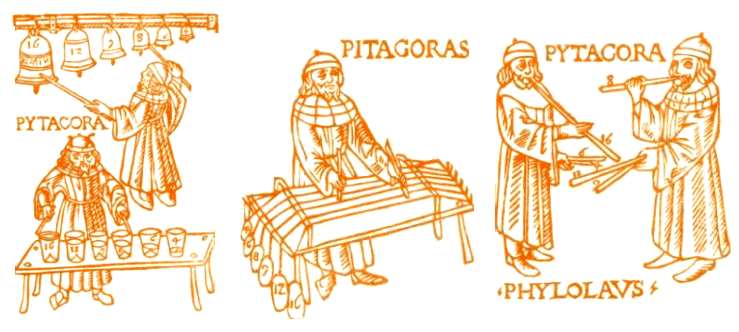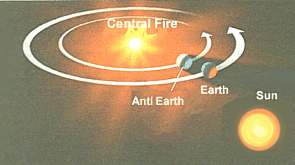|
|
 Pythagoras "the musician" with his student Philolaus Philolaus (or Philolaus) (Φιλόλαος) of Croton, in southern Italy (c. 470 BC - c. 385 BC), Greek mathematician and philosopher, one of the first persons who had the idea that the Earth is a planet. He was a contemporary of Socrates, Democritus, Empedocles, Zeno of Elea, Melissus and Thucydides. Philolaus was a student of Pythagoras. Philolaus was a teacher of Archytas and probably Democritus. Philolaus spoke and wrote in a Greek Doric dialect He published a book on the Pythagorean doctrines, used by Plato in his work Timaeus. Philolaus wrote a book "About the nature". Speusipus, Plato's successor at the Academy summarized Philolaus's work. For most, Earth is in the centre. The Italics, called Pythagoreans, say the opposite: they say that in the centre there is fire, that the Earth is a star and that, rotating around its central part, it creates day and night. Then, opposite to that, they say there is a second Earth, which they call anti-Earth: and they say this not seeking the causes and the reasons in the phenomenons, but forcing the significance of phenomenons and trying to accord them with some preconcept reasons and opinions of theirs. And many others, provided they didn't try to find a certitude in the appraisal of phenomenons rather than in talks, would agree with them in denying that Earth is in the middle. Because they say that the most honourable place is due to the most honourable things, and that fire is worth more than Earth, and the extremes more than the parts comprised between them: and the circumference and the centre are extremes.
The cosmos according to Pythagoreans (Philolaus and others). The earth orbits around a central fire. The Anti-Earth is not visible like the central fire because Greece is on the opposite side on the earth. Philolaus called the central fire Hestia after the goddess of fire and hearth Hestia. Whether this idea was supported by observations or if it was derived only from religious/numerologic reasons is not known. The Greeks rejected later the anti-Earth idea as observations could not confirm this idea: The counter-earth was the first part of the system to be abandoned; and it is suggested that this abandonment was due to the extension of the geographical horizon. Discoveries were made both to the east and to the west. Hanno, the Carthaginian, had made his great voyage of discovery beyond the Pillars of Hercules, and on the other (the eastern) side India became part of the known world. It would naturally be expected that, if journeys were made far enough to the east and west, points would be reached from which it should be possible to see the counter-earth, but, as neither the counter-earth nor the central fire proved in fact to be visible, this portion of the Pythagorean system had to be sacrificed. Heath
 |
|
||||||||||||||||||
